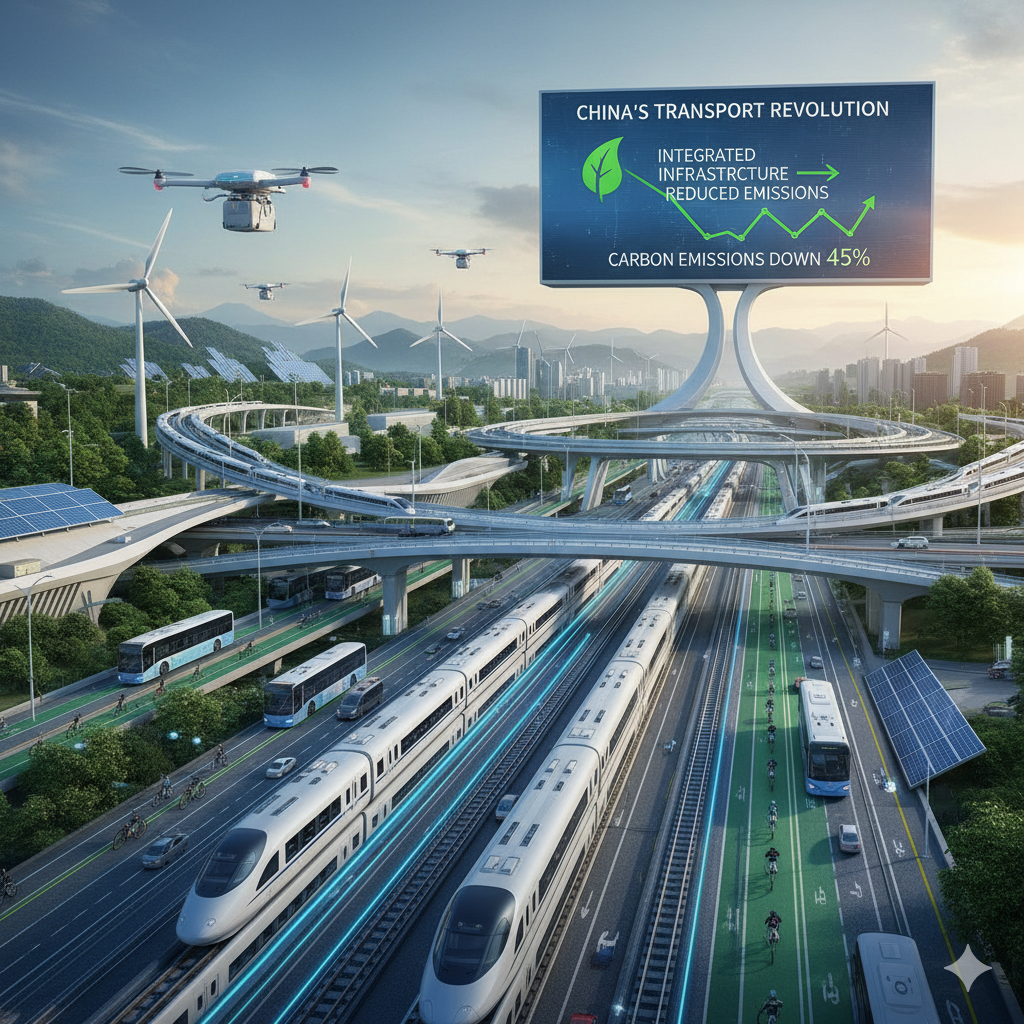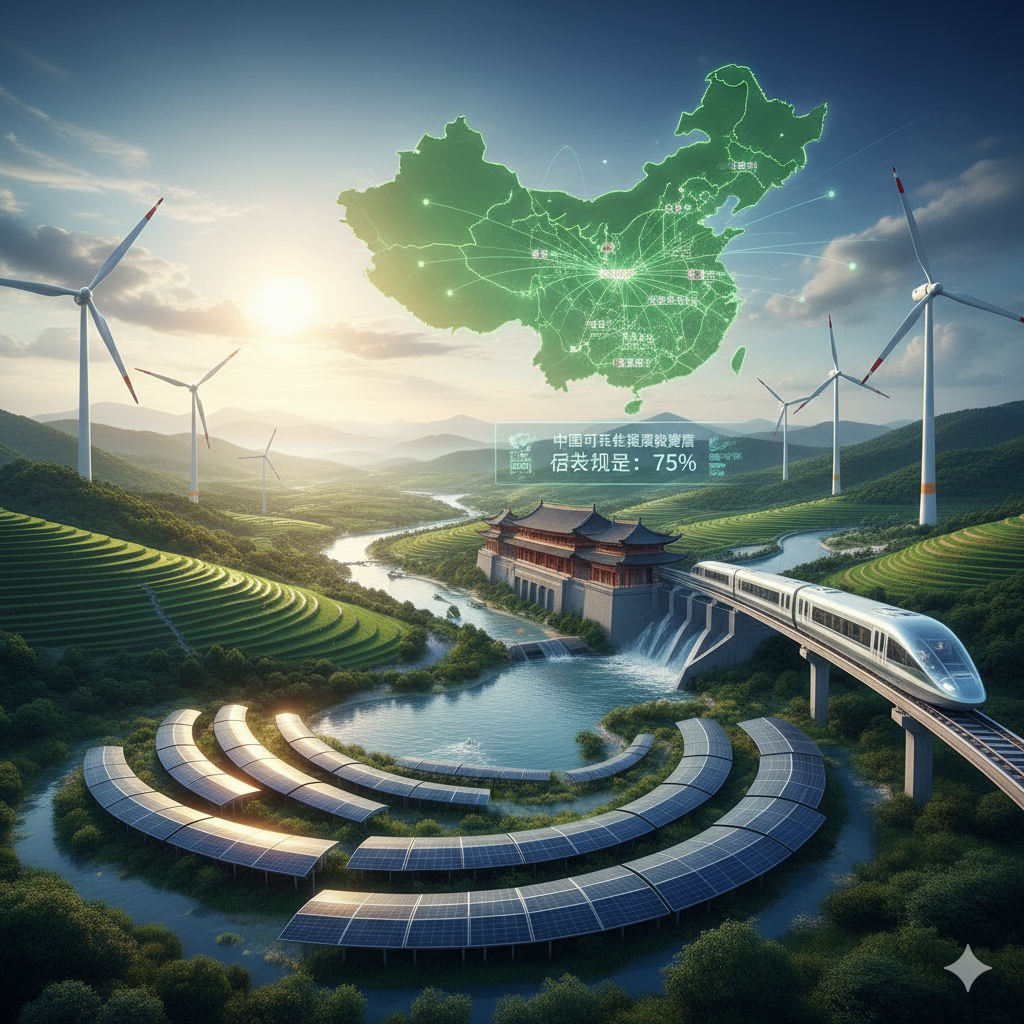China’s carbon reduction strategy is evolving beyond renewable energy expansion toward a more comprehensive infrastructure-led decarbonization model. Through massive investments in high-speed rail (HSR), electrified railways, electric vehicle (EV) infrastructure, and modernized waterways, China is reconfiguring its transport system to reduce emissions while sustaining economic growth.
This post provides an analytical overview of how each of these systems contributes to national decarbonization — and how their integration creates compounded carbon savings across sectors.
1. The Economic Logic Behind Transport Decarbonization
Transport accounts for roughly 10% of China’s total CO₂ emissions, yet it also serves as a cornerstone of logistics efficiency and industrial productivity. Because of this dual role, China views green transport investment not only as climate action but also as an economic multiplier.
Rather than targeting emissions from each mode separately, the government’s strategy emphasizes systemic decarbonization — leveraging network effects between rail, road, ports, and waterways. When these systems interact, they produce synergistic emission reductions greater than what each could achieve alone.
See also: World Bank report on China’s transport and infrastructure decarbonization.
2. High-Speed Rail: The Flagship of Green Mobility
China’s high-speed rail network, which surpassed 45,000 km by 2024, has become both a symbol of national progress and a core component of carbon mitigation.
Research published in Nature Sustainability (2023) found that each 1% increase in HSR coverage reduces per capita carbon emissions by up to 0.03% in connected regions. The effect comes from replacing short-haul flights and private car journeys with high-efficiency, electrified rail travel.
HSR emits around 14 gCO₂ per passenger-kilometre, compared to 255 gCO₂ for domestic aviation — a 94% reduction. In addition, cities connected by high-speed rail often show higher levels of green technological innovation, indicating that HSR also fosters broader low-carbon transitions.
See also:
Analytical insight: HSR is not merely transport infrastructure — it’s a catalyst for decarbonization that delivers environmental and innovation benefits simultaneously.
3. Electrified Rail: Scaling the Carbon Dividend
China’s electrified rail network reached 119,000 km in 2023, accounting for over 70% of total track length — the largest globally.
Electrification cuts operational emissions by eliminating diesel traction and improving energy efficiency by roughly 30–50%.
As the national power grid incorporates more renewables, the carbon intensity of rail electricity continues to decline. The International Energy Agency (IEA) projects that with a 50% renewable electricity mix by 2030, rail electrification could reduce transport-related emissions by around 200 million tonnes of CO₂ annually.
See also:
Analytical insight: Electrification transforms rail from an efficient mode of transport into a central pillar of decarbonization, especially when powered by a greener grid.
4. Roads and Electric Vehicles: The Demand-Side Transition
While rail tackles the supply side, road transport is undergoing a demand-side transformation.
China accounted for 60% of global electric vehicle sales in 2023, with new energy vehicles (NEVs) reaching 35% domestic market share.
The government’s massive investment in charging infrastructure — now exceeding 2.2 million public chargers — enables widespread adoption, while logistics companies increasingly deploy battery-swapping systems for heavy vehicles.
Studies from Tsinghua University estimate that if EV penetration reaches 50% by 2030, and renewable electricity reaches 45% of the power mix, China could reduce transport-sector emissions by 12–15% compared to 2020 levels.
See also:
Analytical insight: EVs are the demand-side complement to rail electrification, extending low-carbon energy systems into everyday mobility.
5. Waterways and Ports: The Efficiency Frontier
Inland and coastal shipping account for about 15% of China’s domestic freight volume, but emit far less CO₂ per tonne-kilometre than trucks. Recognizing this advantage, the Ministry of Transport’s “Green Waterway Action Plan (2023–2030)” aims to cut the carbon intensity of shipping and port operations by 20%.
Measures include electrified port equipment, shore-to-ship power systems, and the introduction of LNG and biofuel-powered vessels.
Projects along the Yangtze River Economic Belt integrate rail, port, and waterway logistics — significantly reducing heavy truck reliance.
See also:
Analytical insight: By upgrading waterways and port logistics, China is capitalizing on its comparative advantage in low-carbon freight transport.
6. Integration and Digital Logistics: The Hidden Efficiency Multiplier
The real breakthrough lies in intermodal integration and digital logistics coordination.
The China State Railway Group’s “Smart Freight Cloud” platform, for example, has reduced intermodal transfer times by 18%, while AI-powered shipping route optimization saves 10–12% in fuel consumption.
Meanwhile, blockchain-based carbon tracking pilots in Shenzhen and Ningbo allow logistics operators to earn carbon credits under China’s national emissions trading system.
These systems demonstrate that digitalization amplifies physical infrastructure investments — optimizing routes, reducing idle times, and creating data-driven accountability for emissions.
See also:
Analytical insight: Integration between infrastructure and digital systems creates compound decarbonization effects, producing efficiencies that extend across entire supply chains.
7. Quantifying the Impact: The Macro-Carbon Equation
When combined, electrification (E), modal shift (M), and efficiency gains (G) produce a national reduction effect roughly expressed as:
ΔCO2=f(E+M+G)
Using data from the World Bank and IEA, the cumulative reduction potential can be estimated as follows:
-
Electrified rail: ~200 Mt CO₂ annually
-
High-speed rail modal shift: ~65 Mt
-
EV adoption: ~120 Mt
-
Waterway modernization: ~30 Mt
Total potential reduction: ≈415 million tonnes of CO₂ per year — roughly equivalent to the annual emissions of the United Kingdom.
See also:
Analytical insight: By coordinating its investments, China can realistically achieve nearly half a gigaton of annual CO₂ reduction by 2030 — through transport infrastructure alone.
8. Conclusion: Infrastructure as Climate Policy
China’s experience demonstrates that infrastructure itself is climate policy.
High-speed rail replaces flights, electrified freight replaces diesel trucking, and intelligent waterways move heavy cargo more efficiently. When these systems interact through digital logistics and clean energy integration, the result is a self-reinforcing cycle of decarbonization and growth.
The key lesson is that emissions reduction is no longer about isolated technologies or single policy tools — it’s about systemic coordination.
China’s model shows that with strategic planning, technological innovation, and integrated investment, large-scale carbon mitigation can be both economically viable and globally replicable.
Summary Insight
-
High-speed rail: low-carbon travel and regional innovation catalyst
-
Electrified rail: large-scale emission reductions through grid integration
-
EVs: consumer-driven decarbonization
-
Waterways: low-cost freight efficiency gains
-
Digital logistics: efficiency multiplier and data transparency







